Anubias plants are a staple in most planted freshwater aquariums, and the Anubias nana is no different.
This small plant can make a big difference in the look of your tank and the enrichment your fish receive.
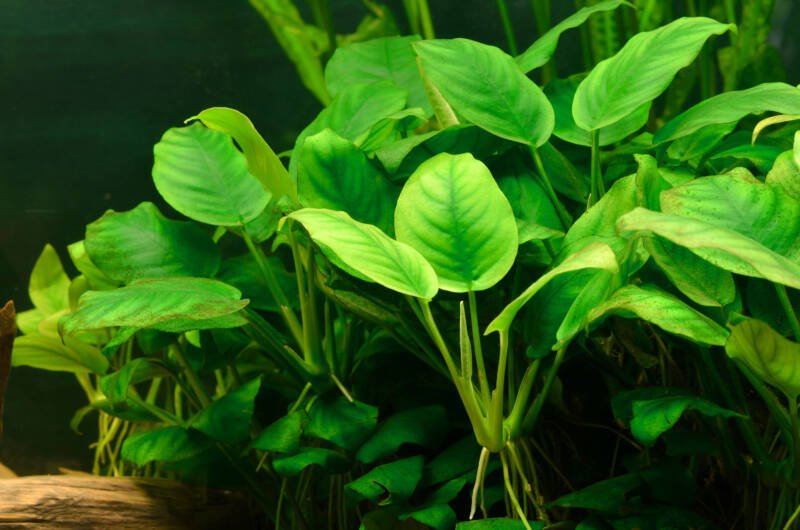
It’s also incredibly hardy, which makes it an excellent beginner plant. In addition to all of this, anubias nana plants also remove pollutants and oxygenate the water.
All of this marks it as both a practical and beautiful addition to planted aquariums.
In this article
Appearance and Basic Care
Anubias nana is, as the name hints, a smaller variety of anubias.
It has short, broad leaves in the classic teardrop shape of many plants. The leaves are deep green in color, though its thick stem is usually darker.
The breadth of the leaves and thickness of the stem will depend on the aquarium conditions and available light and nutrients.
These plants can thrive and propagate either partially or fully submerged, making them a great choice for both aquariums as well as paludariums.
Though rarer, it is possible for this plant to flower. Anubias nana flowers are white in color and greatly resemble peace lily flowers.
Once bloomed, these flowers will typically only last a few months.
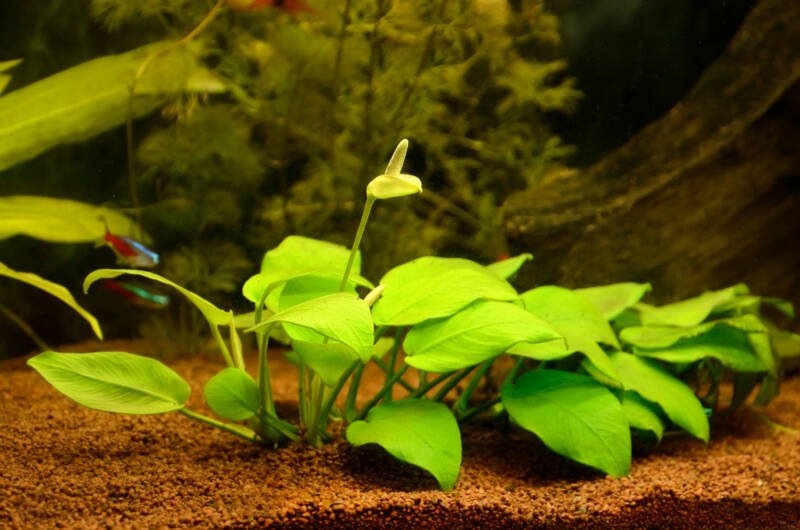
Its roots are typically white and thin before they become established.
It may take some time for them to anchor into the substrate or around driftwood, but they are generally secure once established.
They can grow up to 7.5 inches, but many aquarists choose to keep them cut down to a smaller size.
Anubias nana can also be paired with anubias nana petite, and even smaller variety of anubias. The petite variety will only grow to half the size of the nana if that.
Country of Origin
This species of anubias (Anubias barteri) is native to the shallow river banks of Africa, specifically in Cameroon and Nigeria.
It is found in warmer, slightly acidic water that has a low to moderate current.
As mentioned earlier, they are found in both partially and fully submerged environments.
These places usually also have soft, muddy substrate. This makes it easy for anubias nana to anchor and grow.
All of these conditions are easy to replicate in a home aquarium. And don’t worry— you won’t have to fill your aquarium with mud since not all of these conditions are required.
Basic Tank Setup
Because of their small size, anubias nana are perfect plants for tanks of all sizes. They are suited especially well to nano tanks.
Though tanks of less than five gallons may struggle to stabilize, it can be done with close care and attention.
Anubias nana also is popular foreground and midground plant in larger aquariums.
Tanks of this size easily stabilize. In turn, this makes it easier for aquarists to focus on plant and fish care.

Equipment Check List
Since anubias plants are easier to keep, they need less specialized equipment than some other aquarium plants.
Lighting and substrate are the two most important components of the aquarium.
- Lighting: Anubias nana needs low to moderate lighting. More intense lighting will result in an increased growth rate but must be balanced out with regard to nutrients in order to avoid algae outbreaks.
- Substrate: These plants don’t absolutely require substrate since they can also be attached to driftwood or rocks. However, the fine-grained substrate provides a better anchor and more nutrients.
- Heating: Most species of anubias prefer warmer water, so heaters are required to maintain an acceptable temperature range. Thermometers ensure that aquarists are alerted if the water becomes too hot.
- Carbon Dioxide: Like substrate, CO2 setups are not necessary for anubias to grow. However, anubias nana will propagate more quickly if CO2 is provided. CO2 is available in pressurized and liquid versions.
- Filtration: Since anubias nana is located at the bottom of the tank, it’s not as directly affected by water flow. But keep in mind it prefers a low to moderate current, in case your filter is very powerful.
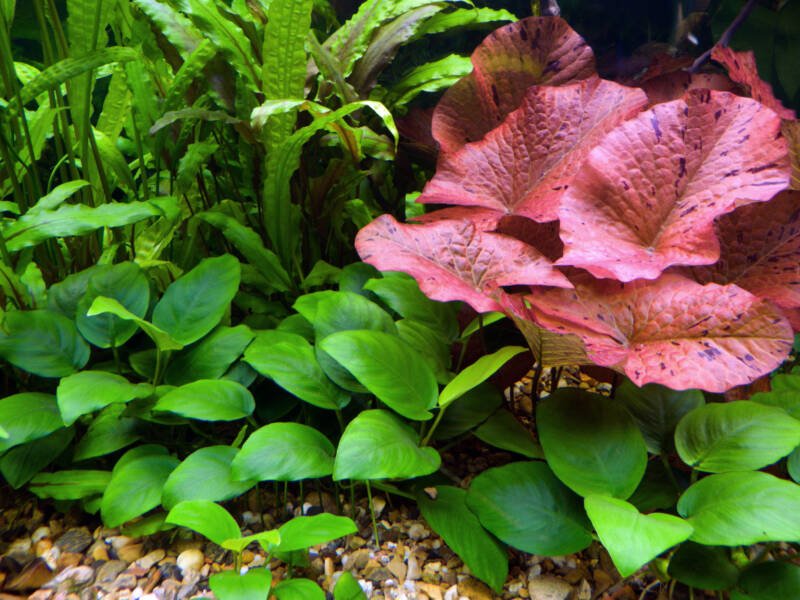
If the substrate is not provided or aquarists don’t want to plant the anubias nana in the substrate, driftwood or another type of anchor will be necessary.
You may need to tie the anubias to the driftwood or décor with a fishing line or twine until its root system becomes more established.
Anubias nana does need to be planted: it will die if kept as a floating plant!
Water Parameters
Anubias, in general, are hardy plants, and the anubias nana is the same.
Because of this, though it has preferred parameters, it can handle slightly wider ranges than those listed below.
- Temperature: Anubias nana can handle warmer temperatures anywhere from 72 – 82°F.
- pH Range: This plant has a narrower range of acceptable pH, only raging from 6 – 7.5.
- Hardness: Any water hardness of 3 – 8 KH is acceptable for anubias nana
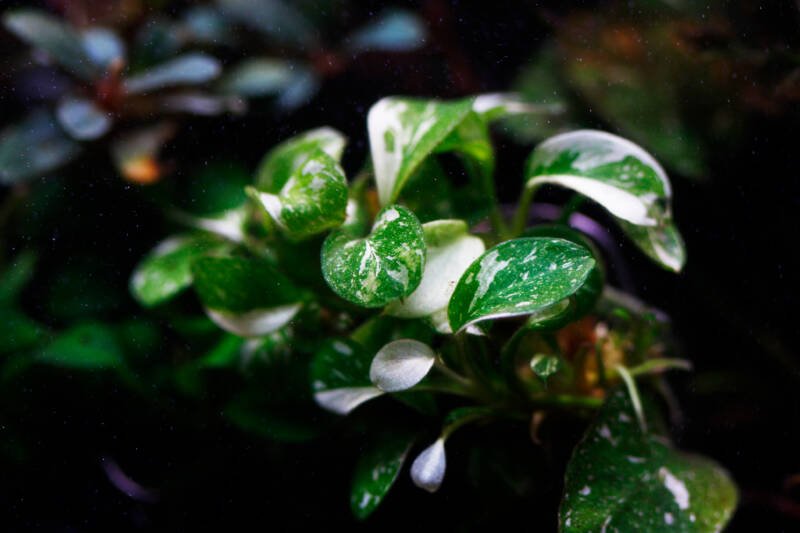
These plants are hardier than others and can tolerate higher levels of ammonia, nitrites, and nitrates.
However, they and fish can still be negatively affected. This is why weekly water changes of at least 25% are necessary. All tank owners should strive to keep ammonia and other chemicals as close to 0 ppm as possible.
A common myth is that planted tanks don’t require water changes since plants absorb pollutants and chemicals.
However, this is only true in tanks that are densely planted and have few inhabitants. In these scenarios, there is only a small bioload for the environment as a whole to support.
But more often than not, tanks still require weekly water changes in order to preserve high water quality and keep the tank clean.
Compatible Fish
Anubias nana is one of the shortest plants available. It also has broad leaves that lie above the bottom of the tank, rather than directly brushing the substrate.
These two characteristics make it ideal for providing cover for bottom-dwellers, such as catfish and loaches.
There are not many fish or other tank inhabitants that can’t be housed with this plant.

But destructive fish or fish that regularly consume aquarium plants should be avoided. For this reason, goldfish and crayfish may not do well with this plant.
However, any tendencies to uproot plants can be easily avoided by anchoring anubias to driftwood rather than planting it in the substrate.
So if aquarists have chosen to display and propagate the plant in this way, there are virtually no limitations to the type of fish they could place in a tank.
Some popular choices include:
- Kuhli, zebra, and yoyo loaches
- Corydoras and bumblebee catfish
- Dwarf and pearl gourami
- Most species of cichlids
- Mollies, barbs, danios, tetras, and guppies
Not all of these fish will actually come into contact with anubias nana since it’s a plant that stays at the bottom of the tank.
However, many of these fish will still appreciate it if they venture close to bottom-dwellers.
These plants also do well with algae eaters, which can keep the anubias nana’s leaves clean.
Propagation Methods
Anubias nana has a slow growth rate. This makes it easy to keep under control, but can be frustrating for aquarists looking to quickly fill in a tank.
A faster growth rate can be encouraged with ample lighting, nutrient-rich substrate or fertilizers, access to CO2, and generous supplements.
But because of its slow growth, most of the time it won’t need a lot of upkeep.
Occasional trimming is required when the stems get too long or if leaves are dying, but otherwise, this plant can be left alone.
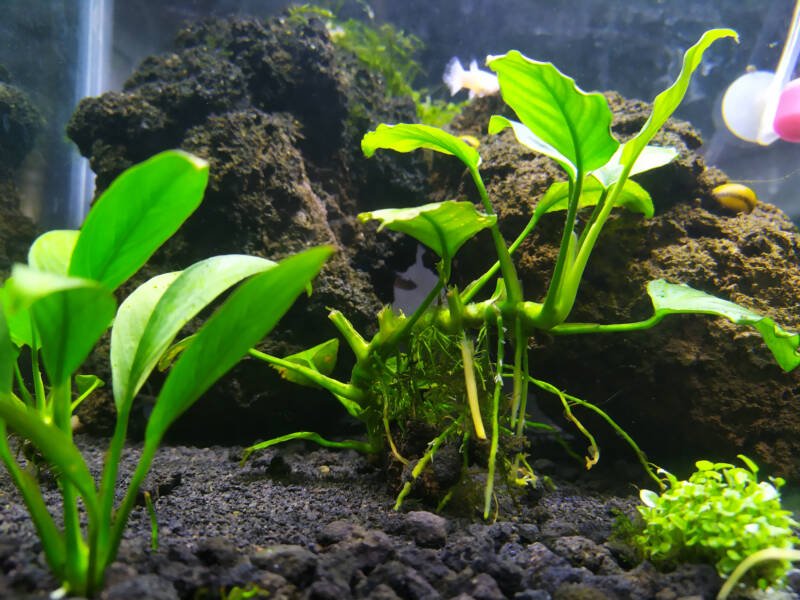
When planting anubias nana in the substrate, make sure not to completely bury the main stem.
Rhizomes grow and break off this stem, falling to the substrate and taking root. Eventually, these fallen rhizomes/ new stems will grow into more anubias nana plants.
This is called rhizome division, and it’s how anubias nana propagates.
Aquarists can more purposefully propagate anubias nana by taking cuttings.
With sharp scissors, you can take cuttings from a fully mature “parent” plant.
Each cutting should have at least three leaves, and should itself be stable. This is indicated by a thicker stem and strong leaf cuticles.
Plant the cuttings in the substrate, and they’ll also eventually grow into anubias nana plants.
Is Anubias Nana Right for Your Tank?
Are you looking for a hardy, small, and beautiful plant?
Then the answer is yes, anubias nana is perfect for your aquarium!
Anubias species have long been a staple in the hobby, and with a good reason.
All of them are very forgiving and great for beginners.
They also have a simplistic beauty that compliments any tank, which even experienced aquarists appreciate.
Though not fast-growing, they more than make up for this with their hardy nature.
They can be planted in almost any size tank and will still thrive under almost any conditions.
Whether you’re unsure about what to plant in your aquarium or are setting up a prize-winning aquascape, you can’t go wrong with anubias nana.